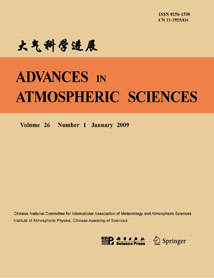| [1] |
Xiaoqing WU, Xiaofan LI,
2008: A Review of Cloud-Resolving Model Studies of Convective Processes, ADVANCES IN ATMOSPHERIC SCIENCES, 25, 202-212.
doi: 10.1007/s00376-008-0202-6
|
| [2] |
GUO Lanli, ZHANG Yaocun, WANG Bin, LI Lijuan, ZHOU Tianjun, BAO Qing,
2008: Simulations of the East Asian Subtropical Westerly Jet by LASG/IAP AGCMs, ADVANCES IN ATMOSPHERIC SCIENCES, 25, 447-457.
doi: 10.1007/s00376-008-0447-0
|
| [3] |
WU Chunqiang, ZHOU Tianjun, SUN De-Zheng, BAO Qing,
2011: Water Vapor and Cloud Radiative Forcings over the Pacific Ocean Simulated by the LASG/IAP AGCM: Sensitivity to Convection Schemes, ADVANCES IN ATMOSPHERIC SCIENCES, 28, 80-98.
doi: 10.1007/s00376-010-9205-1
|
| [4] |
YANG Jing, BAO Qing, WANG Xiaocong, ZHOU Tianjun,
2012: The Tropical Intraseasonal Oscillation in SAMIL Coupled and Uncoupled General Circulation Models, ADVANCES IN ATMOSPHERIC SCIENCES, 29, 529-543.
doi: 10.1007/s00376-011-1087-3
|
| [5] |
REN Rongcai, WU Guoxiong, Ming CAI, YU Jingjing,
2009: Winter Season Stratospheric Circulation in the SAMIL/LASG General Circulation Model, ADVANCES IN ATMOSPHERIC SCIENCES, 26, 451-464.
doi: 10.1007/s00376-009-0451-z
|
| [6] |
LI Jun, WU Guoxiong,
2010: Atmospheric Angular Momentum Transport and Balance in the AGCM-SAMIL, ADVANCES IN ATMOSPHERIC SCIENCES, 27, 1183-1192.
doi: 10.1007/s00376-009-9157-5
|
| [7] |
LI Yaodong, GAO Shouting, LIU Jianwen,
2004: Assessment of Several Moist Adiabatic Processes Associated with Convective Energy Calculation, ADVANCES IN ATMOSPHERIC SCIENCES, 21, 941-950.
doi: 10.1007/BF02915596
|
| [8] |
WU Shu, WU Lixin, LIU Qinyu, Shang-Ping XIE,
2010: Development Processes of the Tropical Pacific Meridional Mode, ADVANCES IN ATMOSPHERIC SCIENCES, 27, 95-99.
doi: 10.1007/s00376-009-8067-x
|
| [9] |
SONG Fengfei, ZHOU Tianjun, and WANG Lu,
2013: Two Modes of the Silk Road Pattern and Their Interannual
Variability Simulated by LASG/IAP AGCM SAMIL2.0, ADVANCES IN ATMOSPHERIC SCIENCES, 30, 908-921.
doi: 10.1007/s00376-012-2145-1
|
| [10] |
DUAN Anmin, WU Guoxiong, LIANG Xiaoyun,
2008: Influence of the Tibetan Plateau on the Summer Climate Patterns over Asia in the IAP/LASG SAMIL Model, ADVANCES IN ATMOSPHERIC SCIENCES, 25, 518-528.
doi: 10.1007/s00376-008-0518-2
|
| [11] |
Yaping WANG, Yongjie HUANG, Xiaopeng CUI,
2019: Surface Rainfall Processes during the Genesis Period of Tropical Cyclone Durian (2001), ADVANCES IN ATMOSPHERIC SCIENCES, 36, 451-464.
doi: 10.1007/s00376-018-8157-8
|
| [12] |
WANG Xiaokang, NI Yunqi, XU Wenhui, GU Chunli, QIU Xuexing,
2011: Water Cycle and Microphysical Processes Associated with a Mesoscale Convective Vortex System in the Dabie Mountain Area, ADVANCES IN ATMOSPHERIC SCIENCES, 28, 1405-1422.
doi: 10.1007/s00376-011-0089-5
|
| [13] |
Zhang Zhenyue,
1988: TROPICAL GRAVITY-ATMOSPHERIC LONG WAVE AND THE WALKER CIRCULATION, ADVANCES IN ATMOSPHERIC SCIENCES, 5, 265-276.
doi: 10.1007/BF02656751
|
| [14] |
Zhang Ren,
1996: Characteristics of Soliton with Dynamic Constraints on its Existence / Propagation in Tropical Easterly Wave, ADVANCES IN ATMOSPHERIC SCIENCES, 13, 325-339.
doi: 10.1007/BF02656850
|
| [15] |
Honglei ZHANG, Ming XUE, Hangfeng SHEN, Xiaofan LI, Guoqing ZHAI,
2024: Local Torrential Rainfall Event within a Mei-Yu Season Mesoscale Convective System: Importance of Back-Building Processes, ADVANCES IN ATMOSPHERIC SCIENCES, 41, 847-863.
doi: 10.1007/s00376-023-3033-6
|
| [16] |
Guo Pinwen, Tian Hong, Liu Xuanfei,
2000: Tropical Convective Activities Related to Summer Rainfall Anomaly in China, ADVANCES IN ATMOSPHERIC SCIENCES, 17, 121-128.
doi: 10.1007/s00376-000-0048-z
|
| [17] |
HUANG Wei, LIANG Xudong,
2010: Convective Asymmetries Associated with Tropical Cyclone Landfall: beta-Plane Simulations, ADVANCES IN ATMOSPHERIC SCIENCES, 27, 795-806.
doi: 10.1007/s00376-009-9086-3
|
| [18] |
Hepeng ZHENG, Yun ZHANG, Lifeng ZHANG, Hengchi LEI, Zuhang WU,
2021: Precipitation Microphysical Processes in the Inner Rainband of Tropical Cyclone Kajiki (2019) over the South China Sea Revealed by Polarimetric Radar, ADVANCES IN ATMOSPHERIC SCIENCES, 38, 65-80.
doi: 10.1007/s00376-020-0179-3
|
| [19] |
Zhang Ren, Yu Zhihao,
2000: Low-Frequency CISK-Rossby Wave and Stratospheric QBO in the Tropical Atmosphere, ADVANCES IN ATMOSPHERIC SCIENCES, 17, 311-321.
doi: 10.1007/s00376-000-0012-y
|
| [20] |
Xiaofan LI, SHEN Xinyong,
2012: Temporal and Spatial Scale Dependence of Precipitation Analysis over the Tropical Deep Convective Regime, ADVANCES IN ATMOSPHERIC SCIENCES, 29, 1390-1394.
doi: 10.1007/s00376-012-1269-7
|















 AAS Website
AAS Website 
 AAS WeChat
AAS WeChat 
 DownLoad:
DownLoad: